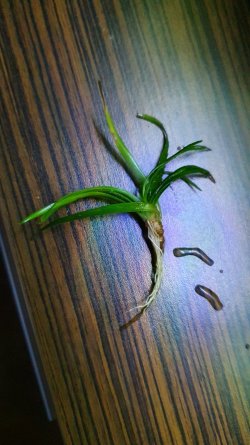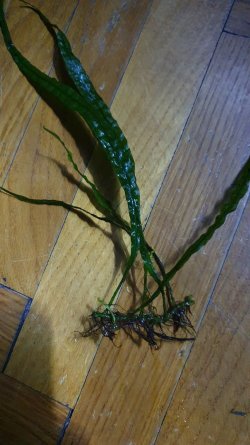You are using an out of date browser. It may not display this or other websites correctly.
You should upgrade or use an alternative browser.
You should upgrade or use an alternative browser.
New plant ID
- Thread starter Bicyclemaster
- Start date
The April FOTM Contest Poll is open!

🏆 Click to vote! 🏆
The second photo is Java fern. It is usually grown attached to decor as the rhizome rots if buried.
I have no idea about the first one though
I have no idea about the first one though
The first is either Helanthium tenellum [common name usually pygmy chain sword] or Sagittaria subulata [common name dwarf Sagittaria]. I would suspect the first to be it, from the tuber/rhizome and the leaves Once planted, it will when settled send out runners with adventitious plants. This is a very lovely and useful plant.
@Essjay is of course right on with the Java Fern. Tie it to tock or wood.
@Essjay is of course right on with the Java Fern. Tie it to tock or wood.
Bicyclemaster
Fish Fanatic
Thank you so much, where I live I haven't seen java fern in any store so I am not used to how it looks.The second photo is Java fern. It is usually grown attached to decor as the rhizome rots if buried.
I have no idea about the first one though
Bicyclemaster
Fish Fanatic
Thanks a lot! I have it under a 20lm/liter light and it isn't doing that well so I wanted to know wat plant it is and check if i'm giving it too mucb light by any chance.The first is either Helanthium tenellum [common name usually pygmy chain sword] or Sagittaria subulata [common name dwarf Sagittaria]. I would suspect the first to be it, from the tuber/rhizome and the leaves Once planted, it will when settled send out runners with adventitious plants. This is a very lovely and useful plant.
@Essjay is of course right on with the Java Fern. Tie it to tock or wood.
Thanks a lot! I have it under a 20lm/liter light and it isn't doing that well so I wanted to know wat plant it is and check if i'm giving it too mucb light by any chance.
There seems to be evidence of algae beginning, so the light may be in need of reducing. How long is it on?
Also are you using any fertilizers now?
Bicyclemaster
Fish Fanatic
Yes, I do have some hair algae. The light is on for 8h a day. It turns on for 4h, than it stops for 7h and than starts for another 4h. I think my algae problems comes from the fact that the tank received daylight all day long. It's in a room South facing windows sadly. I coverd one side with something but the top and front of the tank still gets hit by the light.There seems to be evidence of algae beginning, so the light may be in need of reducing. How long is it on?
Also are you using any fertilizers now?
Yes, I do have some hair algae. The light is on for 8h a day. It turns on for 4h, than it stops for 7h and than starts for another 4h. I think my algae problems comes from the fact that the tank received daylight all day long. It's in a room South facing windows sadly. I coverd one side with something but the top and front of the tank still gets hit by the light.
There is a problem here for fish. The period of "daylight" which is when the tank light is on must be one continuous period. Use a timer to have it regular. You can read more on why this is crucial here:
The "daylight" can be any time of day, provided it is consistent, and there is ambient room light so the fish are not stressed by on/off lighting. Plants also benefit, and algae finds it a bit harder with a continuous period assuming nutrients are balanced.
Daylight does benefit algae, I had this in two tanks for a few years until I figured this out. Especially in summer the longer and brighter days alone can cause algae to increase.
Since you had problem algae with the "siesta" approach, you will likely want to reduce the daylight hours. Six is about as low as you want to go, though some members have reported luck with just five hours, my tanks had 7 and algae increases disappeared for the past 7 years.
Bicyclemaster
Fish Fanatic
I do have a timer for the light. There is pretty much always some ambient light in the room so I think the fish are not that stressed when the lights come on or turn off. Right now in winter it's not that much light as it's cloudy everyday, but in summer it's a different storyThere is a problem here for fish. The period of "daylight" which is when the tank light is on must be one continuous period. Use a timer to have it regular. You can read more on why this is crucial here:
The "daylight" can be any time of day, provided it is consistent, and there is ambient room light so the fish are not stressed by on/off lighting. Plants also benefit, and algae finds it a bit harder with a continuous period assuming nutrients are balanced.
Daylight does benefit algae, I had this in two tanks for a few years until I figured this out. Especially in summer the longer and brighter days alone can cause algae to increase.
Since you had problem algae with the "siesta" approach, you will likely want to reduce the daylight hours. Six is about as low as you want to go, though some members have reported luck with just five hours, my tanks had 7 and algae increases disappeared for the past 7 years.
I started using the "siesta" method when I first started the tank as from my understanding it can help the plants grow healthier. I don't know if it's true or not, but by having a break like this the ants will have some time to produce more CO2 and use it in the second half of the light period. Secondly, I don't know how reserched this is, some people claim that plants start photosynthesis as soon as they have enough light while algae starts after some time.
The stranges thing for me is that algae grows on my fastest growing pla ts mostly, on the vallisneria. I think it's because I trim it regularly because it would otherwise cover the water surface and this of course stresses the plant.
If I'm not mistaken I pretty much get some algae on every plant that I trim. Some may not get any but it's random.
I would go with vallisneria on the 1st one
The Siesta approach can benefit plants, but doing so at the expense of the fish is not advisable, and if you read my article I linked it explains how serious light is to fish.
To explain how the siesta approach may help plants. Plants will photosynthesize to the max under adequate light intensity (spectrum matters too), until something they need is no longer available. CO2 in a natural or low-tech planted tank is produced primarily by the decomposition of organics in the substrate. Fish, plants and some bacteria respire 24/7, but the amount of CO2 these produce is limited when it comes to fast-growing plants. So assuming everything else is available, CO2 is the first factor to become insufficient for photosynthesis. Having a period of several hours with the tank light off allows the CO2 to rebuild. However, the detriment this does to the fish is not worth it.
To explain how the siesta approach may help plants. Plants will photosynthesize to the max under adequate light intensity (spectrum matters too), until something they need is no longer available. CO2 in a natural or low-tech planted tank is produced primarily by the decomposition of organics in the substrate. Fish, plants and some bacteria respire 24/7, but the amount of CO2 these produce is limited when it comes to fast-growing plants. So assuming everything else is available, CO2 is the first factor to become insufficient for photosynthesis. Having a period of several hours with the tank light off allows the CO2 to rebuild. However, the detriment this does to the fish is not worth it.
Bicyclemaster
Fish Fanatic
Yep, I read the entire article yesterday. I think I'll change the light schedule and let it on for 8h straight and see what happens. See if the algae grow drastically. I actually have diy CO2 in the tank and I managed to make it quite stable so I don't think this will affect the plants too much.The Siesta approach can benefit plants, but doing so at the expense of the fish is not advisable, and if you read my article I linked it explains how serious light is to fish.
To explain how the siesta approach may help plants. Plants will photosynthesize to the max under adequate light intensity (spectrum matters too), until something they need is no longer available. CO2 in a natural or low-tech planted tank is produced primarily by the decomposition of organics in the substrate. Fish, plants and some bacteria respire 24/7, but the amount of CO2 these produce is limited when it comes to fast-growing plants. So assuming everything else is available, CO2 is the first factor to become insufficient for photosynthesis. Having a period of several hours with the tank light off allows the CO2 to rebuild. However, the detriment this does to the fish is not worth it.
Latest Discussions
- Replies
- 0
- Views
- 32
- Replies
- 0
- Views
- 18
- Replies
- 0
- Views
- 21
- Replies
- 2
- Views
- 50
trending
-
-
-
-
-
F-1 Angel... a bit nervous... it'll be my 1st F-1 fish...
- Started by Magnum Man
- Replies: 17
Staff online
-
FishmanicTFF Contest Czar



